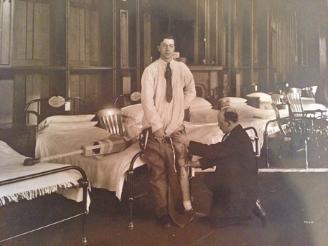UofG shines light on Erskine archive
Published: 23 November 2015
Historical documents and artefacts charting the history of Erskine Hospital have been recovered and are being formally catalogued by UofG for the first time.
Historical documents and artefacts charting the history of Erskine Hospital, some of which lay hidden in a derelict room for years, have been recovered and are being formally catalogued for the first time.
Much of the precious archive was unearthed in a locked room, discovered by a member of staff in a disused part of an Erskine Hospital building.
It is not known how long the objects and archive material had been stored in the room of the former Princess Louise Scottish Hospital for Sailors and Soldiers, but some items date back to the original founding of the hospital which celebrates its centenary next year.
The University of Glasgow’s Archives Services, through funding from the Wellcome Trust, has now teamed up with the veterans’ charity Erskine and appointed an archivist and a preservation assistant to work through the boxes of material to catalogue their contents.
Some of the items recovered include woodworking tools used by some of the recovering soldiers as part of their rehabilitation and training in new skills. They made a wide range of wooden medical appliances for disabled soldiers including the then revolutionary Erskine Leg - a prosthetic limb designed and pioneered by Sir William Macewen,co-founder of the hospital and Regius Professor of Surgery at the University of Glasgow.
 It was Sir William’s compassion and determination to improve the lives of amputees in WW1 which led to the advancement in prosthetics. The archive contains a full collection of wooden shoe-size moulds used in the workshops for the manufacture of prosthetic legs.
It was Sir William’s compassion and determination to improve the lives of amputees in WW1 which led to the advancement in prosthetics. The archive contains a full collection of wooden shoe-size moulds used in the workshops for the manufacture of prosthetic legs.
The archive collection will be stored and preserved at the University of Glasgow Archives, and Erskine are currently working on a patient database of every soldier admitted and discharged at the hospital during its history which will be a valuable research resource for families tracing their relatives’ history.
Dr Tony Pollard, Senior lecturer in History and Battlefield Archaeology, at the University of Glasgow, said: “What we are unearthing at Erskine is quite remarkable. There are boxes upon boxes of wartime history which will shine a light on so many personal stories of bravery and endurance during the First World War, but also the incredible advancement in the treatment of injured personnel not just physically but mentally since 1916.
“This archive will not only chart the hospital’s history but also provide an insight into the many medical developments over the last century, methods which helped change care practices towards casualties of war around the globe. I am quite certain once we really start to delve into the vast collection, the findings will be used in research for many years to come.”
The archive team is hoping to find an original Erskine Leg and is appealing for public help. Only one known Macewen designed Erskine Leg survives in the British Museum, but archivists and historians at the University of Glasgow are convinced more could be still out there and are appealing to members of the public for help on this matter.
First published: 23 November 2015
<< November

